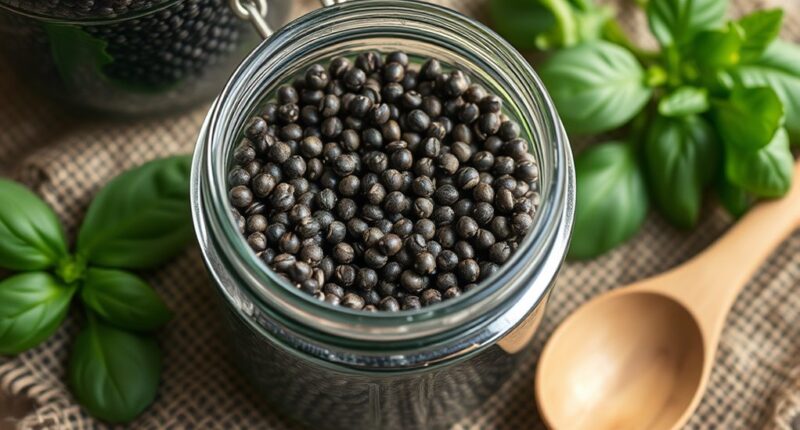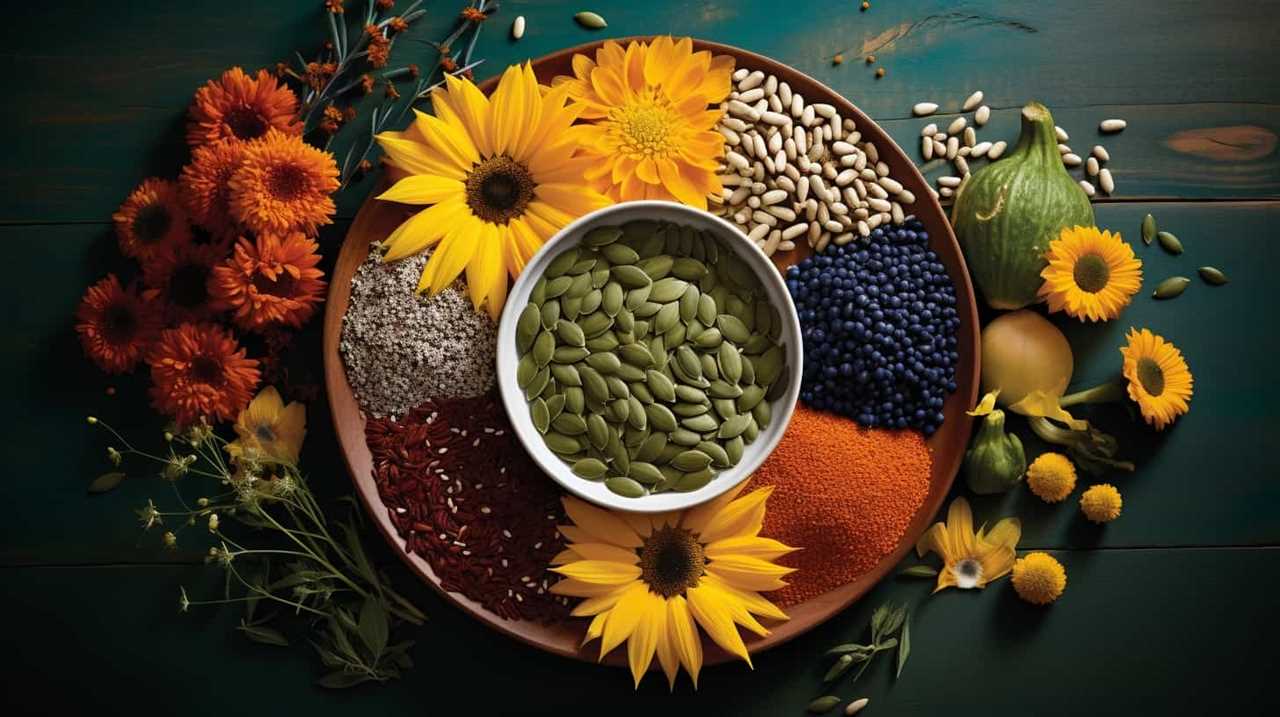To grow chia seeds successfully, start with well-drained, neutral to slightly acidic soil tested for ideal conditions. Plant when soil temperatures reach 65-85°F, and guarantee your growing season is long enough for full maturation. Keep the soil moist but not waterlogged, and mulch to help retain moisture. Harvest seeds when flower heads turn brown and dry, then dry, clean, and store them in a cool, dark place. Continue exploring this guide for detailed tips on each step.
Key Takeaways
- Select well-drained, nutrient-rich soil with a neutral to slightly acidic pH and ensure soil temperature reaches 65-85°F before planting.
- Sow chia seeds directly into the soil or start indoors; keep soil consistently moist but not waterlogged.
- Ensure full growing season for flowering and seed production, using mulching to retain moisture and suppress weeds.
- Harvest when flower heads turn brown and seeds naturally shed; dry seeds thoroughly before extraction.
- Store harvested seeds in an airtight container in a cool, dark place to maintain freshness and viability.

Growing chia seeds is simple if you understand the basic steps. Once you get the hang of it, you’ll find that cultivating chia is rewarding and straightforward. However, like any crop, it comes with its share of challenges in cultivation, such as maintaining proper soil conditions, managing watering schedules, and protecting your plants from pests. Chia plants thrive in well-drained soil with a neutral to slightly acidic pH, so testing your soil beforehand helps guarantee ideal growth. Consistent watering is vital, especially during germination and early development, but overwatering can cause root rot. Keep the soil moist but not waterlogged, and consider mulching to retain moisture and suppress weeds. As your plants grow taller, watch for pests like aphids or fungal issues, which can hinder development if left unchecked. Staying vigilant and practicing integrated pest management will boost your success. Additionally, understanding soil health and its impact on plant growth can significantly improve your cultivation results.
When it comes to harvesting, understanding harvesting techniques is equally important. Chia seeds are ready to harvest once the flower heads turn brown and start to shed seeds naturally. This indicates the seeds have matured and are ready for collection. To harvest, you can cut the seed heads by hand or use scissors, placing them in a paper bag or container. Gently drying the seed heads in a warm, dry location helps loosen the seeds and prevents mold. Once dried, you’ll want to extract the seeds carefully. A common technique involves rubbing the seed heads between your hands or using a fine mesh screen to separate the seeds from the chaff. This process requires patience to avoid losing too many seeds during separation. After cleaning, store the seeds in an airtight container in a cool, dark place to preserve freshness and prevent spoilage.
Throughout the cultivation process, keep in mind that timing is vital for both planting and harvesting. Plant chia seeds when the soil temperature reaches around 65-85°F, and guarantee your growing season is long enough for the plants to mature fully. If you’re growing in a shorter season, starting indoors or using greenhouse conditions can give you a head start. Regularly monitor your plants’ growth, adjusting watering and care as needed. When harvesting, act promptly once the seeds are mature, because waiting too long can lead to seed loss or shattering. With proper planning, attention to detail, and patience, you’ll find that growing chia seeds can be a highly satisfying experience, providing you with nutritious seeds to enjoy in your diet.
Frequently Asked Questions
Can Chia Seeds Be Grown Indoors Successfully?
You can definitely grow chia seeds indoors successfully through container cultivation. Indoor gardening provides a controlled environment, ensuring your chia seeds get enough light and warmth. Use a shallow container with well-draining soil, and water regularly to keep the soil moist. Place the container in a sunny spot or under grow lights. With proper care, your chia seeds will sprout and thrive indoors, making it a rewarding indoor gardening project.
What Are the Common Pests Affecting Chia Plants?
You should be aware that pests like aphids, spider mites, and fungus gnats can affect your chia plants. Proper pest identification helps you target specific issues early. Use natural pest control methods, such as introducing beneficial insects or applying neem oil, to keep pests at bay. Regularly inspect your plants, and act quickly if you notice any signs of infestation to guarantee healthy growth.
How Long Does It Take for Chia Seeds to Mature?
Think of chia seed ripening as a slow but steady dance. Typically, you’ll see chia seeds mature within 7 to 14 days after flowering. The harvesting timeline depends on your climate and growing conditions, so keep an eye out for the seeds turning a dark color and the plant’s leaves yellowing. Patience pays off—your chia seeds are almost ready to harvest once they reach this stage.
Are There Specific Climate Conditions Ideal for Chia Growth?
You wonder if specific climate conditions are ideal for chia growth. Chia plants have good climate adaptability, thriving in warm temperatures around 65-85°F. They prefer full sun and well-draining soil. While they can tolerate some drought, consistent moisture helps. Avoid frost and very cold conditions, as they hinder growth. By maintaining appropriate temperature requirements, you guarantee healthy chia plants and a successful harvest.
How Do I Harvest and Store Chia Seeds Properly?
Imagine the moment you see chia seeds ripen, ready for harvest. You gently cut the seed heads and hang them upside down in a warm, dry area for seed drying. Once thoroughly dry, you carefully shell the seeds and store them in airtight storage containers to keep them fresh. Proper harvesting and storage guarantee your chia seeds stay flavorful and nutritious, ready for your next healthy recipe.
Conclusion
Now that you’ve mastered the art of growing chia seeds, get ready to watch tiny green specks transform into mighty superfoods. Soon, your garden will resemble a miniature jungle, complete with chia plants fighting for sunlight like tiny green warriors. Just imagine, one day you’ll be harvesting these feisty little seeds, all while feeling like a chia-growing legend. Who knew gardening could turn you into a seed-slinging superhero? Happy planting—your chia empire awaits!









